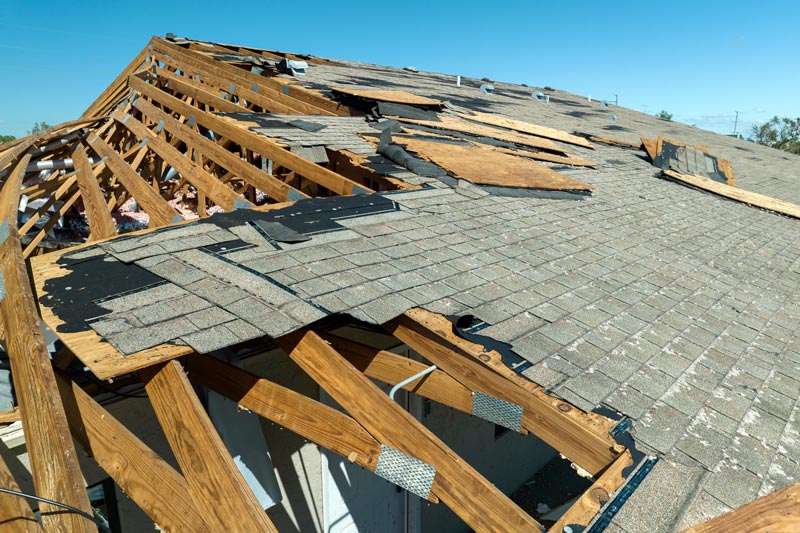By Thad Brown, Owner – Dynamic Alliance Roofing LLC, Wisconsin Rapids, WI
Storm season always has a way of keeping roofers busy—and not just because of the obvious stuff like missing shingles or branches poking through the ceiling. A lot of the damage that happens during a storm doesn’t come with flashing lights or warning signs. It shows up quietly, in ways that are easy to miss until it becomes a much bigger problem.
After roofing for over 40 years in Wisconsin Rapids and beyond, I’ve seen every kind of storm damage there is—some of it loud and dramatic, but a lot of it subtle and sneaky. That sneaky stuff? That’s what gets you. Below are five signs that your roof might’ve taken a hit during the last storm, even if everything still looks fine from your front yard.
1. Gutters Full of Granules
Let’s start with something you probably won’t notice unless you’re cleaning out your gutters (or watching someone else do it from the comfort of a lawn chair). If you spot what looks like black or gray sand in the bottom of the gutter, that’s not a weird type of dirt—it’s granules from your shingles.
Shingles are coated in granules to protect them from the sun and help them shed water. When those granules start falling off in clumps after a storm, it means the shingles have taken a beating. They might still be up there, holding on for dear life, but their protective layer is long gone. And once that layer goes, it’s only a matter of time before water gets where it doesn’t belong.
2. Shingles That Look Like They’ve Had a Bad Day
Sometimes, storm damage doesn’t mean missing shingles—it just means angry-looking shingles. If you notice that some are curled, creased, or look like they’ve been through a stressful experience, they probably have.
High winds can lift shingles just enough to break the seal underneath or crease the edges. Once that seal is broken, the next gust might send those shingles flying, or worse, let water sneak in under them. And once water gets underneath the roof surface, the rest of the system starts playing defense—and not very well.
3. Metal That’s Dinged Up or Pulled Away
Flashing, vents, exhaust pipes, and chimney caps are like the roof’s finishing touches. They’re there to keep water from getting in where different materials meet. The problem is, they’re also storm magnets.
If hail or debris dented or loosened any of these metal components, it’s easy to overlook. A little ding might not seem like a big deal—until it starts redirecting water straight into your attic insulation. Keep an eye out for anything that looks bent, cracked, rusted, or like it’s not quite where it used to be.
4. Spots on the Ceiling That Weren’t There Last Week
This is where the inside of the house starts tattling on the roof. A new spot on the ceiling—no matter how small or innocent-looking—is worth paying attention to. Water doesn’t exactly knock on the front door before it enters. It finds the path of least resistance and slowly works its way through insulation, drywall, and paint.
That little brown circle in the hallway might not mean much today, but give it a few weeks and you’ll be explaining to your dinner guests why your ceiling looks like a coffee stain. If a spot shows up after a storm, it’s time to take a closer look—preferably before buckets become part of the home decor.
5. Debris That Decided to Settle In
Roofs are supposed to shed water. That job gets a whole lot harder when branches, leaves, or mystery debris decide to hang out on top. Valleys and low-pitched areas are especially prone to collecting stuff after a storm.
All that debris traps moisture, slows drainage, and creates a cozy environment for mold or algae. It can also hide damage that’s already occurred underneath. So if the roof looks like it’s hosting a small forest after a storm, it’s worth clearing things off and checking what’s going on underneath.
Why Catching These Signs Early Matters
The problem with subtle storm damage is that it doesn’t get better on its own. It waits. Quietly. Then one day, when the snow melts or the next big storm hits, it decides to introduce itself—with leaks, water stains, or rot.
A quick inspection, especially after a major storm, can save a lot of trouble down the line. Some of the worst roof problems I’ve seen started with something as simple as a lifted shingle or a dented vent cap. A trained eye can spot these things early and recommend fixes before the damage spreads.
Of course, not everyone enjoys climbing up on a roof to squint at shingles, and that’s understandable. But whether it’s from the ground, through binoculars, or with the help of a professional, giving the roof a post-storm checkup is always a smart move.
After four decades in this business, one thing hasn’t changed—roofs don’t complain when they’re damaged. They just wait. And the sooner those quiet signs get noticed, the easier and cheaper things are to fix.
If the roof took a hit in the last storm—even if it’s not obvious—it might be trying to say something. Listen carefully. It usually starts with a granule here and a ceiling spot there. That’s the roof’s way of asking for a little attention before things get messy.



